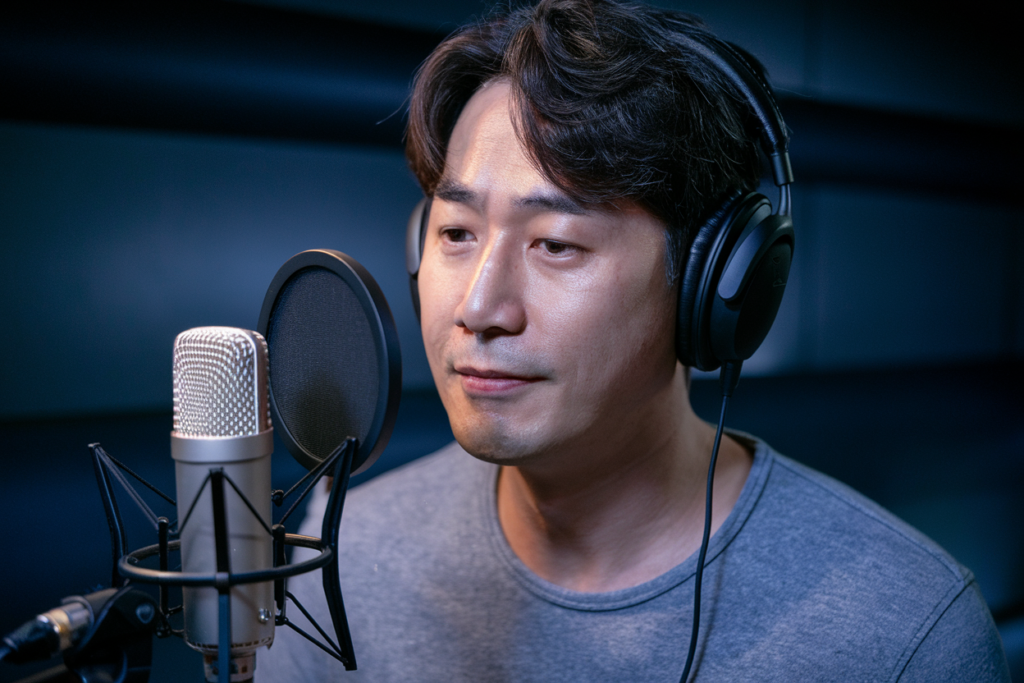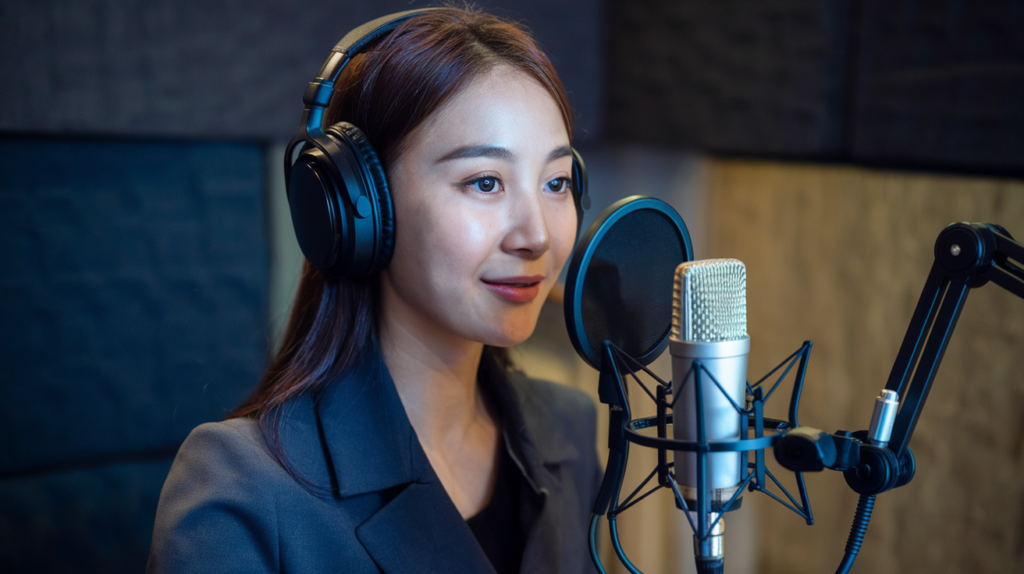Key Takeaways
- Lip Sync Importance: Perfect synchronization between spoken words and character mouth movements is essential for creating an immersive viewer experience in Korean voiceovers.
- Techniques for Mastery: Understanding phonetics, timing, and utilizing visual cues are critical techniques that enhance lip sync effectiveness in voice acting.
- Collaboration Matters: Close collaboration with directors and sound engineers is vital for refining timing adjustments during recording sessions, leading to improved performance quality.
- Cultural Awareness: Recognizing cultural nuances and differences in language structure helps voice actors deliver authentic lines that resonate with the audience.
- Utilize Technology: High-quality audio and video editing software, along with specialized tools like phonetic mapping applications, can significantly aid in achieving precise lip sync.
- Best Practices: Regular practice, attention to character authenticity, and openness to feedback from peers are essential for continuous improvement as a voice actor.
Ever watched a Korean drama and wondered how those voiceovers seem so perfectly in sync? Perfecting lip sync in Korean voiceovers is an art that can elevate your projects to a whole new level. Whether you’re diving into the world of dubbing or just want to enhance your skills, mastering this technique is crucial.
Overview of Lip Sync in Voiceovers
Lip sync plays a crucial role in the quality of voiceovers, especially in Korean projects. Achieving perfect synchronization between spoken words and character mouth movements creates an immersive experience for viewers. You want audiences to believe they’re hearing the original dialogue, so precision is key.
Many factors impact lip sync accuracy. Timing and rhythm are essential when matching audio with visual cues. A voice actor must grasp the emotional tone and pacing to ensure that their delivery aligns seamlessly with the on-screen action. Misalignment can disrupt engagement, pulling viewers out of the story.
Practicing techniques like phonetic mapping can enhance your skills as a voice artist. This method involves analyzing how specific sounds correspond to mouth shapes and movements in various languages, including Korean. You’ll find that understanding these nuances leads to better performance and more realistic results.
Collaboration among voice talents also influences lip sync effectiveness. Working closely with directors and sound engineers helps refine timing adjustments during recording sessions. Feedback loops allow you to make necessary tweaks, ensuring that every line resonates perfectly with its corresponding visuals.
Mastering lip sync requires dedication and attention to detail from all involved parties—voice artists, directors, and production teams alike. With practice, you can elevate your work as a voice over talent while providing an exceptional experience for your audience.
Importance of Perfecting Lip Sync
Perfecting lip sync in voiceovers significantly enhances viewer engagement. When the spoken words align seamlessly with a character’s mouth movements, it creates an immersive experience that captivates audiences.
Enhancing Viewer Experience
Lip sync mastery directly impacts how viewers perceive and connect with the content. It transforms a standard viewing experience into something memorable and engaging. You’ll notice that when audio matches visual cues perfectly, it feels more natural, drawing audiences deeper into the narrative. This level of synchronization makes characters relatable and believable, allowing your audience to invest emotionally in their stories.
Maintaining Character Authenticity
Maintaining character authenticity hinges on effective lip sync. A voice actor must embody not just the dialogue but also the essence of their character through precise timing and emotional delivery. When you nail the synchronization of speech and movement, it reflects genuine characterization. Viewers can sense when a character’s voice aligns with their actions, leading to stronger connections and enhanced storytelling. This authenticity ensures that every project resonates well with its intended audience, making your work as a voice talent all the more impactful.
Techniques for Lip Sync Mastery
Perfecting lip sync in Korean voiceovers combines artistry with technical skill. You’ll want to focus on key techniques that enhance your performance and ensure your voice aligns seamlessly with the visuals.
Understanding Phonetics and Timing
Understanding phonetics is crucial for effective lip sync. Each Korean sound corresponds to specific mouth shapes, making it essential to analyze these connections. When you know how different sounds manifest visually, you can anticipate when to deliver lines for maximum impact. Additionally, timing plays a significant role in matching your spoken words with character movements. Practicing rhythmic delivery helps align your voiceover perfectly with on-screen actions, creating an authentic viewing experience.
Utilizing Visual Cues and Context
Visual cues provide vital information about the characters’ emotions and intentions. Pay attention to facial expressions and body language during performances; they guide your vocal delivery. Context matters too—knowing the scene’s emotional tone allows you to adjust pacing accordingly. For instance, during intense moments, quickening your speech while maintaining clarity enhances engagement. By synchronizing your audio closely with visual elements, you create a more immersive experience that resonates deeply with viewers.
Mastering these techniques transforms ordinary voiceovers into captivating narratives that draw audiences in and leave lasting impressions.
Common Challenges in Korean Voiceovers
Korean voiceovers present unique challenges that require careful attention and skill. Understanding these hurdles helps you navigate the complex landscape of dubbing effectively.
Cultural Nuances
Cultural nuances significantly affect voiceover work. Different expressions, humor, and emotional tones can vary greatly from one culture to another. It’s essential for voice actors to grasp these subtle differences to deliver lines authentically. For instance, what might be a light-hearted joke in English could fall flat or even offend in Korean. Being culturally aware enhances the immersive experience for viewers, ensuring that the characters resonate well with their audience.
Differences in Language Structure
Differences in language structure also pose challenges for voice talent. Korean has distinct phonetic elements and grammatical patterns compared to English. This divergence affects timing and rhythm during delivery. For example, sentence length and complexity often differ between languages, which can lead to discrepancies when syncing audio with visual cues. Voice artists must adapt their pacing and articulation to maintain synchronization while ensuring clarity and emotional impact are preserved across all lines.
Navigating these common challenges requires practice and collaboration among voice actors, directors, and sound engineers. Understanding cultural nuances alongside structural differences leads to outstanding performances that captivate audiences while preserving the integrity of the original content.
Tools and Software for Lip Sync
Perfecting lip sync in Korean voiceovers requires the right tools and software. These resources help voice actors synchronize their performances with on-screen actions effectively, ensuring a natural flow that captivates audiences.
Recommended Technology
High-quality audio and video editing software are essential for effective lip sync. Consider using programs like Adobe Audition or Avid Pro Tools for audio manipulation, as they offer robust features tailored to voiceover work. For video alignment, tools such as Adobe Premiere Pro or Final Cut Pro allow you to visualize mouth movements alongside the audio track. Additionally, specialized lip-sync software like Reallusion iClone can assist in automating some aspects of synchronization, making it easier for you to focus on your performance.
Features to Look For
When selecting technology for lip sync, prioritize features that enhance precision and usability:
- Timeline Editing: Choose software with intuitive timeline editing capabilities so you can easily adjust timing.
- Waveform Visualization: Look for platforms that display waveforms; this visual aid helps align audio cues with character movements.
- Phonetic Mapping Tools: Opt for programs that offer phonetic analysis tools; these can guide your delivery by showing how sounds correspond to mouth shapes.
- Collaboration Capabilities: Ensure the tool supports collaboration features; working closely with directors and sound engineers improves overall performance quality.
- Intuitive Interface: Select user-friendly applications; an easy-to-navigate interface makes mastering the software simpler.
By utilizing the right tools and focusing on essential features, you’ll elevate your voiceover skills and create compelling content that resonates deeply with viewers.
Best Practices for Voice Actors
Perfecting lip sync in Korean voiceovers requires a blend of skill and technique. Here are some best practices to enhance your performance as a voice actor.
- Understand Phonetics: Each Korean sound correlates with specific mouth shapes. Familiarizing yourself with phonetics helps anticipate how to deliver lines effectively.
- Pay Attention to Timing: Timing plays a crucial role in aligning your voiceovers with on-screen actions. Practice rhythmic delivery to create a seamless experience for viewers.
- Observe Visual Cues: Characters’ facial expressions and body language provide essential guidance for vocal delivery. Adjust your pacing according to the emotional tone of the scene; this adds depth and realism.
- Embrace Character Authenticity: Capturing the essence of your character is vital. Effective lip sync reflects genuine emotions, making characters more relatable and believable.
- Utilize Appropriate Tools: High-quality audio editing software ensures precise manipulation of sound, while visualization tools help synchronize mouth movements with audio tracks efficiently.
- Collaborate Effectively: Work closely with directors and sound engineers during recording sessions. Their insights can refine timing, ensuring every line resonates well with visuals.
- Practice Regularly: Consistent practice sharpens your skills over time, helping you navigate common challenges like cultural nuances or differences in language structure seamlessly.
- Stay Open to Feedback: Constructive criticism from peers can enhance your performance significantly, offering fresh perspectives on areas that may need improvement.
By embracing these practices, you elevate not only your own skills but also contribute meaningfully to the quality of the final product in any project you undertake as a voice artist.
Conclusion
Perfecting lip sync in Korean voiceovers is a journey that requires dedication and skill. By embracing techniques like phonetic mapping and focusing on timing and emotional delivery, you can significantly enhance your performance.
Collaboration with other professionals in the industry will also elevate your work, ensuring that every line resonates well with its visuals. Remember to utilize the right tools for effective synchronization and practice regularly to refine your craft.
With these strategies in mind, you’ll not only improve your skills but also create more engaging narratives that captivate audiences. Keep pushing yourself to master this art form, and watch as your voiceovers transform into compelling experiences that leave a lasting impression.
Frequently Asked Questions
What is the importance of lip sync in Korean voiceovers?
Lip sync is essential in Korean voiceovers as it ensures that spoken words match character mouth movements, creating a more immersive experience for viewers. Perfect synchronization enhances the quality of projects, making characters relatable and believable.
How can voice actors improve their lip sync skills?
Voice actors can improve their lip sync skills by understanding phonetics, focusing on timing and rhythm, observing visual cues from characters, and practicing regularly. Utilizing specialized tools and collaborating with directors can also enhance performance.
What techniques are effective for mastering lip sync?
Effective techniques include phonetic mapping to align sounds with mouth shapes, maintaining proper timing during delivery, and adjusting pacing according to emotional tone. Observing facial expressions and body language is crucial for guiding vocal delivery.
What challenges do voice actors face in Korean dubbing?
Voice actors may encounter challenges like cultural nuances and differences in language structure. These factors affect timing and emotional delivery, requiring adaptability to maintain clarity while achieving synchronization.
How does technology aid in perfecting lip sync?
Technology plays a vital role by providing high-quality audio/video editing software like Adobe Audition or Avid Pro Tools. Specialized tools like Reallusion iClone automate synchronization aspects, allowing actors to focus on performance while ensuring accurate alignment with visuals.
What best practices should voice actors follow for better performances?
Best practices include understanding phonetics for line anticipation, focusing on timing with visual cues, embracing character authenticity, utilizing appropriate tools effectively, collaborating with directors/sound engineers, practicing regularly, and being open to feedback for continuous improvement.







